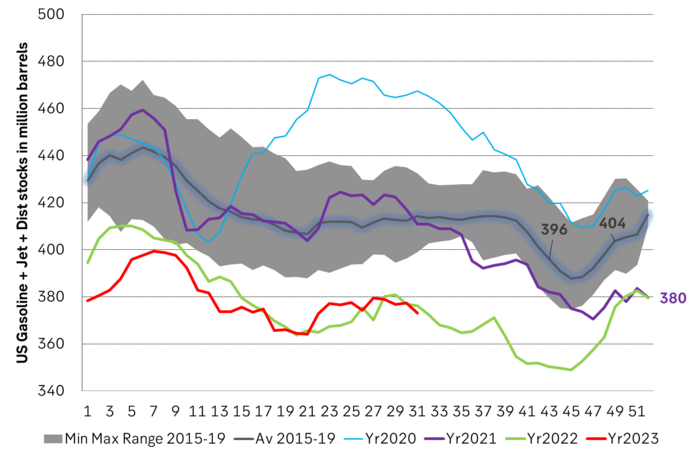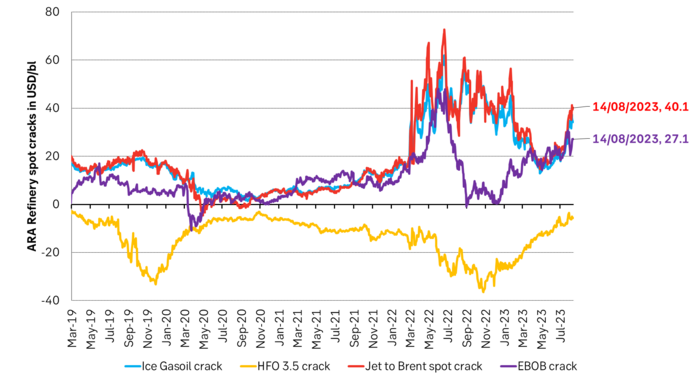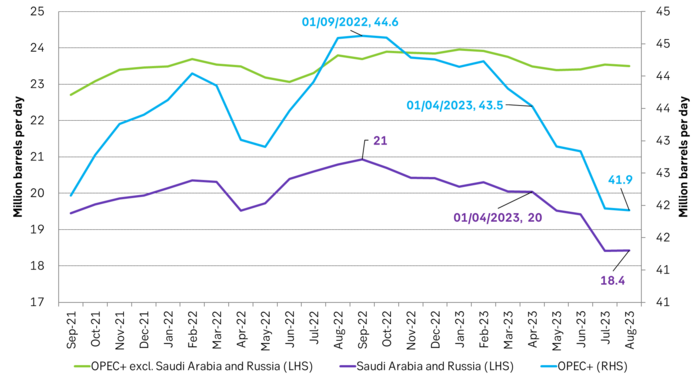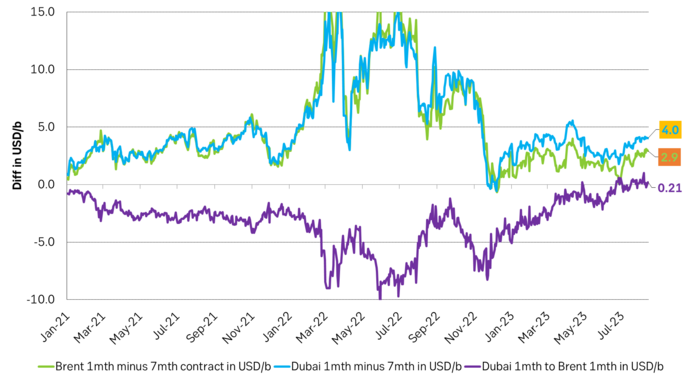Analys
We can confidently say yet again that Saudi Arabia is the boss

Crude oil prices are pulling back this morning on China concerns. But Saudi Arabia is probably very happy with the overall situation. It has showed the oil market yet again who’s the boss and the world will also need more of its oil in the coming months. The global market is set to run a deficit of 1.7 m b/d in Q4-23 according to the latest IEA report if Russia and Saudi Arabia sticks to their current production. After now having put the market strait there is no reason for Saudi Arabia to let such a deep deficit and inventory draw actually play out. It would lead to much higher prices but Saudi would also receive a lot of political pain from the US, China, India, Europe. Why ruin the party with oil rallying above USD 100/b and drive up an ugly political debacle when oil at USD 85/b is such a beautiful place. Tapering of Saudi Arabia’s cuts in Q4-23 would be the natural thing to expect. But all through September at least there should be a very sharp and tight market.

Through most of the first half of this year all up until late June there was deep disagreement with respect to global oil demand. In its June oil market report (STEO), the US EIA projected an oil demand in Q4-23 of 101.8 m b/d while the IEA in its OMR report the same month projected a Q4-23 demand of 103.5 m b/d. Such magnitudes of diverging views with respect to global oil demand is very rare. Markets didn’t really know what to believe with deep fear of deteriorating economic outlook on top due to sky rocketing interest rates around the world and a sluggish Chinese economy. The actual level of global oil demand is usually something we only really know in hindsight. With lots of facts in hand the IEA now estimates that global demand was 103 m b/d in June and expects it to be 103.1 m b/d in Q4-23.
The world did indeed get a strong rebound in global oil demand as the world increasingly and fully emerged from Covid-19 restrictions. Increased flying, driving and strong demand for petrochemicals. But it took a little longer to materialize than expected and it was shrouded in fears over the direction of the global economy. Global demand at 103 m b/d is not about a vigorously growing global economy but mostly about normalization post Covid-19. The IEA now estimates that global demand this year will average 102.2 m b/d versus 99.9 m b/d in 2022 giving a rebound of 2.2 m b/d YoY. But if it hadn’t been for Covid-19 then global oil demand would probably have been averaging close to 106 m b/d this year and 106.5 m b/d in H2-23 if we assume the normal 1.3% oil demand growth since 2019 had taken place. Much of this normal oil demand growth is due to population growth which is relentlessly rising higher. There is thus still a potentially huge, pent up demand for oil which may have built up during the Covid-19 years. Whether that potential pent up demand will actually emerge or not remains to be seen. But for now we are at a solid 103 m b/d demand. This is what the market can see and believe in. But significant pent up demand may be lurking behind the curtains.
Saudi Arabia was probably very frustrated with financial oil markets as they sold oil heavily in H1-23 and drove prices lower even as Saudi Arabia could see in its physical oil books that demand was robust. Saudi Arabia made deep cuts to production from 10.5 m b/d in April and all the way down to almost 9.0 m b/d in July with same level also in August and September. This isn’t Saudi Arabia’s first rodeo and it has really showed the market yet again who’s the boss.
Global oil demand normally rises by 1.3 m b/d from H1 to H2. Production from OPEC+ has however declined by 1.6 m b/d from April to August. And market is now very tight. If Saudi Arabia and Russia sticks to their current production levels throughout H2-23 then the IEA projects a draw in global oil inventories of 1.7 m b/d. That is a big, big draw which would drive oil prices yet higher. The price of sour crude (Dubai) which normally trades at at discount to sweet crudes is now instead trading at a premium. That is how tight the sour crude market has gotten.
But Saudi Arabia now has plenty of spare capacity at hand and it can easily lift production by 1.5 m b/d again back up to 10.5 m b/d. While they may chose to keep production at around 9.0 m b/d for a little while longer they have no good reason to drive the oil price up to USD 100-110/b. That will only give them large political problems with their main consumers. For sure neither the US nor China or India will be very happy.
Saudi Arabia should be fully content for the moment. It has shown the market yet again who’s the boss. It has driven the oil price back up to a very satisfying level of USD 85/b (ish). The world needs more of its oil and Saudi has spare capacity to provide it. Could it be better? Hardly.
US oil inventories with and without SPR. We still haven’t seen a decline in US crude and product stocks excluding SPR. But that will be the proof of the pudding. A running global deficit of 1.7 m b/d will eventually show up in declining US crude and product stocks.

Main oil product stocks in the US are lower this year than last year. At least a little. Refining margins are very strong as a result of reviving global demand for gasoline and jet fuel. When refining margins are strong then refineries make a lot of money and then they buy a lot of crude oil to make more.

Refining margins ticked lower following crazy levels in 2022 but have now shot back up again as demand for gasoline and jet fuel has revived post Covid-19.

Significant cuts from Saudi Arabia and some cuts by Russia has made total OPEC+ production fall like a rock (blue line). But that also means there is more spare capacity at hand.

The sharp decline in production from OPEC+ has led to a rebound in the time spreads for both Brent crude and Dubai crude. The tightening by OPEC+ is so large that Dubai sour crude now trades at a premium to Brent crude which is highly unusual (lilac graph).

Analys
Tightening fundamentals – bullish inventories from DOE

The latest weekly report from the US DOE showed a substantial drawdown across key petroleum categories, adding more upside potential to the fundamental picture.

Commercial crude inventories (excl. SPR) fell by 5.8 million barrels, bringing total inventories down to 415.1 million barrels. Now sitting 11% below the five-year seasonal norm and placed in the lowest 2015-2022 range (see picture below).
Product inventories also tightened further last week. Gasoline inventories declined by 2.1 million barrels, with reductions seen in both finished gasoline and blending components. Current gasoline levels are about 3% below the five-year average for this time of year.
Among products, the most notable move came in diesel, where inventories dropped by almost 4.1 million barrels, deepening the deficit to around 20% below seasonal norms – continuing to underscore the persistent supply tightness in diesel markets.
The only area of inventory growth was in propane/propylene, which posted a significant 5.1-million-barrel build and now stands 9% above the five-year average.
Total commercial petroleum inventories (crude plus refined products) declined by 4.2 million barrels on the week, reinforcing the overall tightening of US crude and products.


Analys
Bombs to ”ceasefire” in hours – Brent below $70

A classic case of “buy the rumor, sell the news” played out in oil markets, as Brent crude has dropped sharply – down nearly USD 10 per barrel since yesterday evening – following Iran’s retaliatory strike on a U.S. air base in Qatar. The immediate reaction was: “That was it?” The strike followed a carefully calibrated, non-escalatory playbook, avoiding direct threats to energy infrastructure or disruption of shipping through the Strait of Hormuz – thus calming worst-case fears.

After Monday morning’s sharp spike to USD 81.4 per barrel, triggered by the U.S. bombing of Iranian nuclear facilities, oil prices drifted sideways in anticipation of a potential Iranian response. That response came with advance warning and caused limited physical damage. Early this morning, both the U.S. President and Iranian state media announced a ceasefire, effectively placing a lid on the immediate conflict risk – at least for now.
As a result, Brent crude has now fallen by a total of USD 12 from Monday’s peak, currently trading around USD 69 per barrel.
Looking beyond geopolitics, the market will now shift its focus to the upcoming OPEC+ meeting in early July. Saudi Arabia’s decision to increase output earlier this year – despite falling prices – has drawn renewed attention considering recent developments. Some suggest this was a response to U.S. pressure to offset potential Iranian supply losses.
However, consensus is that the move was driven more by internal OPEC+ dynamics. After years of curbing production to support prices, Riyadh had grown frustrated with quota-busting by several members (notably Kazakhstan). With Saudi Arabia cutting up to 2 million barrels per day – roughly 2% of global supply – returns were diminishing, and the risk of losing market share was rising. The production increase is widely seen as an effort to reassert leadership and restore discipline within the group.
That said, the FT recently stated that, the Saudis remain wary of past missteps. In 2018, Riyadh ramped up output at Trump’s request ahead of Iran sanctions, only to see prices collapse when the U.S. granted broad waivers – triggering oversupply. Officials have reportedly made it clear they don’t intend to repeat that mistake.
The recent visit by President Trump to Saudi Arabia, which included agreements on AI, defense, and nuclear cooperation, suggests a broader strategic alignment. This has fueled speculation about a quiet “pump-for-politics” deal behind recent production moves.
Looking ahead, oil prices have now retraced the entire rally sparked by the June 13 Israel–Iran escalation. This retreat provides more political and policy space for both the U.S. and Saudi Arabia. Specifically, it makes it easier for Riyadh to scale back its three recent production hikes of 411,000 barrels each, potentially returning to more moderate increases of 137,000 barrels for August and September.
In short: with no major loss of Iranian supply to the market, OPEC+ – led by Saudi Arabia – no longer needs to compensate for a disruption that hasn’t materialized, especially not to please the U.S. at the cost of its own market strategy. As the Saudis themselves have signaled, they are unlikely to repeat previous mistakes.
Conclusion: With Brent now in the high USD 60s, buying oil looks fundamentally justified. The geopolitical premium has deflated, but tensions between Israel and Iran remain unresolved – and the risk of missteps and renewed escalation still lingers. In fact, even this morning, reports have emerged of renewed missile fire despite the declared “truce.” The path forward may be calmer – but it is far from stable.
Analys
A muted price reaction. Market looks relaxed, but it is still on edge waiting for what Iran will do

Brent crossed the 80-line this morning but quickly fell back assigning limited probability for Iran choosing to close the Strait of Hormuz. Brent traded in a range of USD 70.56 – 79.04/b last week as the market fluctuated between ”Iran wants a deal” and ”US is about to attack Iran”. At the end of the week though, Donald Trump managed to convince markets (and probably also Iran) that he would make a decision within two weeks. I.e. no imminent attack. Previously when when he has talked about ”making a decision within two weeks” he has often ended up doing nothing in the end. The oil market relaxed as a result and the week ended at USD 77.01/b which is just USD 6/b above the year to date average of USD 71/b.

Brent jumped to USD 81.4/b this morning, the highest since mid-January, but then quickly fell back to a current price of USD 78.2/b which is only up 1.5% versus the close on Friday. As such the market is pricing a fairly low probability that Iran will actually close the Strait of Hormuz. Probably because it will hurt Iranian oil exports as well as the global oil market.
It was however all smoke and mirrors. Deception. The US attacked Iran on Saturday. The attack involved 125 warplanes, submarines and surface warships and 14 bunker buster bombs were dropped on Iranian nuclear sites including Fordow, Natanz and Isfahan. In response the Iranian Parliament voted in support of closing the Strait of Hormuz where some 17 mb of crude and products is transported to the global market every day plus significant volumes of LNG. This is however merely an advise to the Supreme leader Ayatollah Ali Khamenei and the Supreme National Security Council which sits with the final and actual decision.
No supply of oil is lost yet. It is about the risk of Iran closing the Strait of Hormuz or not. So far not a single drop of oil supply has been lost to the global market. The price at the moment is all about the assessed risk of loss of supply. Will Iran choose to choke of the Strait of Hormuz or not? That is the big question. It would be painful for US consumers, for Donald Trump’s voter base, for the global economy but also for Iran and its population which relies on oil exports and income from selling oil out of that Strait as well. As such it is not a no-brainer choice for Iran to close the Strait for oil exports. And looking at the il price this morning it is clear that the oil market doesn’t assign a very high probability of it happening. It is however probably well within the capability of Iran to close the Strait off with rockets, mines, air-drones and possibly sea-drones. Just look at how Ukraine has been able to control and damage the Russian Black Sea fleet.
What to do about the highly enriched uranium which has gone missing? While the US and Israel can celebrate their destruction of Iranian nuclear facilities they are also scratching their heads over what to do with the lost Iranian nuclear material. Iran had 408 kg of highly enriched uranium (IAEA). Almost weapons grade. Enough for some 10 nuclear warheads. It seems to have been transported out of Fordow before the attack this weekend.
The market is still on edge. USD 80-something/b seems sensible while we wait. The oil market reaction to this weekend’s events is very muted so far. The market is still on edge awaiting what Iran will do. Because Iran will do something. But what and when? An oil price of 80-something seems like a sensible level until something do happen.
-

 Nyheter3 veckor sedan
Nyheter3 veckor sedanStor uppsida i Lappland Guldprospekterings aktie enligt analys
-

 Nyheter4 veckor sedan
Nyheter4 veckor sedanBrookfield ska bygga ett AI-datacenter på hela 750 MW i Strängnäs
-

 Nyheter4 veckor sedan
Nyheter4 veckor sedanSommaren inleds med sol och varierande elpriser
-

 Nyheter4 veckor sedan
Nyheter4 veckor sedanOPEC+ ökar oljeproduktionen trots fallande priser
-

 Nyheter3 veckor sedan
Nyheter3 veckor sedanSilverpriset släpar efter guldets utveckling, har mer uppsida
-

 Analys4 veckor sedan
Analys4 veckor sedanBrent needs to fall to USD 58/b to make cheating unprofitable for Kazakhstan
-

 Nyheter4 veckor sedan
Nyheter4 veckor sedanTradingfirman XTX Markets bygger datacenter i finska Kajana för 1 miljard euro
-

 Nyheter2 veckor sedan
Nyheter2 veckor sedanUppgången i oljepriset planade ut under helgen









